Assessing Uncertainties of Water Footprints Using an Ensemble of Crop Growth Models on Winter Wheat
Abstract
:1. Introduction
2. Materials and Methods
2.1. Experimental Data
2.2. Model Runs and Model Ensemble
3. Results
3.1. Simulated Water Consumption
3.2. Simulated Crop Yield
3.3. Water Footprint
4. Discussion
5. Conclusions
Acknowledgments
Author Contributions
Conflicts of Interest
References
- Hoekstra, A.Y. Virtual Water Trade: Proceedings of the International Expert Meeting on Virtual Water Trade; Value of Water Research Report Series No 12; UNESCO-IHE: Delft, The Netherlands, 2003. [Google Scholar]
- Hoekstra, A.Y.; Chapagain, A.K. Globalization of Water: Sharing the Planet’s Freshwater Resources; Blackwell Publishing: Oxford, UK, 2008; p. 220. [Google Scholar]
- Allan, J.A. Virtual water: A strategic resource. Global solutions to regional deficits. Ground Water 1998, 36, 545–546. [Google Scholar] [CrossRef]
- Hoekstra, A.Y.; Hung, P.Q. Globalisation of water resources: International virtual water flows in relation to crop trade. Glob. Environ. Chang. 2005, 15, 45–56. [Google Scholar] [CrossRef]
- Berger, M.; Finkbeiner, M. Methodological Challenges in Volumetric and Impact-Oriented Water Footprints. J. Ind. Ecol. 2013, 17, 79–89. [Google Scholar] [CrossRef]
- Hoekstra, A.Y.; Chapagain, A.K. Water footprints of nations: Water use by people as a function of their consumption pattern. Water Resour. Manag. 2007, 21, 35–48. [Google Scholar] [CrossRef]
- Liu, J.; Zehnder, A.J.B.; Yang, H. Global consumptive water use for crop production: The importance of green water and virtual water. Water Resour. Res. 2009, 45, W05428. [Google Scholar] [CrossRef]
- Mekonnen, M.M.; Hoekstra, A.Y. A global and high-resolution assessment of the green, blue and grey water footprint of wheat. Hydrol. Earth Syst. Sci. 2010, 14, 1259–1276. [Google Scholar] [CrossRef] [Green Version]
- Siebert, S.; Döll, P. Quantifying blue and green virtual water contents in global crop production as well as potential production losses without irrigation. J. Hydrol. 2010, 384, 198–207. [Google Scholar] [CrossRef]
- Hoekstra, A.Y.; Chapagain, A.K.; Aldaya, M.M.; Mekonnen, M.M. The Water Footprint Manual: Setting the Global Standard; Water Footprint Network Earthscan: London, UK, 2011; p. 203. [Google Scholar]
- Jensen, M.E.; Burman, R.D.; Allen, R.G. Evapotranspiration and Irrigation Water Requirements. In ASCE Manuals and Reports on Engineering Practice; American Society of Civil Engineers: New York, NY, USA, 1990; Volume 70, p. 360. [Google Scholar]
- Weiß, M.; Menzel, L. A global comparison of four potential evapotranspiration equations and their relevance to stream flow modelling in semi-arid environments. Adv. Geosci. 2008, 18, 15–23. [Google Scholar] [CrossRef]
- Allen, R.G.; Pereira, L.S.; Raes, D.; Smith, M. Crop Evapotranspiration: Guidelines for Computing Crop Water Requirements; FAO Irrigation and Drainage Paper 56; Food and Agriculture Organization: Rome, Italy, 1998. [Google Scholar]
- Smith, M.; Allen, R.; Pereira, L. Revised FAO Methodology for Crop Water Requirements. In Proceedings of the Consultants Meeting on Management of Nutrients and Water in Rainfed Arid and Semi-Arid Areas, Vienna, Austria, 26–29 May 1997; International Atomic Energy Agency: Vienna, Austria, 1998; pp. 51–58. [Google Scholar]
- Mekonnen, M.M.; Hoekstra, A.Y. The green, blue and grey water footprint of crops and derived crop products. Hydrol. Earth Syst. Sci. 2011, 15, 1577–1600. [Google Scholar] [CrossRef] [Green Version]
- Trnka, M.; Eitzinger, J.; Dubrovsky, M.; Semerádová, D.; Stepánek, P.; Hlavinka, P.; Balek, J.; Skala, K.P.; Farda, A.; Formayer, H.; et al. Is rainfed crop production in central Europe at risk? Using a regional climate model to produce high resolution agroclimatic information for decision makers. J. Agric. Sci. 2010, 148, 639–656. [Google Scholar] [CrossRef]
- Trnka, M.; Olesen, J.E.; Kersebaum, K.C.; Skjelvag, A.O.; Eitzinger, J.; Seguin, B.; Peltonen-Sainio, P.; Rötter, R.; Iglesias, A.; Orlandini, S.; et al. Agroclimatic conditions in Europe under climate change. Glob. Chang. Biol. 2011, 17, 2298–2318. [Google Scholar] [CrossRef] [Green Version]
- Wassenaar, T.; Lagacherie, P.; Legros, J.-P.; Rounsevell, M.D.A. Modelling wheat yield responses to soil and climate variability at the regional scale. Clim. Res. 1999, 11, 209–220. [Google Scholar] [CrossRef]
- Kersebaum, K.C.; Lorenz, K.; Reuter, H.I.; Schwarz, J.; Wegehenkel, M.; Wendroth, O. Operational use of agro-meteorological data and GIS to derive site specific nitrogen fertilizer recommendations based on the simulation of soil and crop growth processes. Phys. Chem. Earth 2005, 30, 59–67. [Google Scholar] [CrossRef]
- Kersebaum, K.C.; Nendel, C. Site-specific impacts of climate change on wheat production across regions of Germany using different CO2 response functions. Eur. J. Agron. 2014, 52, 22–32. [Google Scholar] [CrossRef]
- Walker, W.E.; Harremoës, P.; Rotmans, J.; Van der Sluijs, J.P.; Van Asselt, M.B.A.; Janssen, P.; Von Krauss, M.P.K. Defining uncertainty: A conceptual basis for uncertainty management in model-based decision support. Integr. Assess. 2003, 4, 5–17. [Google Scholar] [CrossRef]
- Scherer, L.; Pfister, S. Dealing with uncertainty in water scarcity footprints. Environ. Res. Lett. 2016, 11, 054008. [Google Scholar] [CrossRef]
- Palosuo, T.; Kersebaum, K.C.; Angulo, C.; Hlavinka, P.; Moriondo, M.; Olesen, J.; Patil, R.; Ruget, F.; Rumbaur, C.; Takac, J.; et al. Simulation of winter wheat yield and its variability in different climates of Europe: A comparison of eight crop growth models. Eur. J. Agron. 2011, 35, 103–114. [Google Scholar] [CrossRef]
- Rötter, R.P.; Palosuo, T.; Kersebaum, K.C.; Angulo, C.; Bindi, M.; Ewert, F.; Ferrise, R.; Hlavinka, P.; Moriondo, M.; Nendel, C.; et al. Simulation of spring barley yield in different climatic zones of Northern and Central Europe: A comparison of nine crop models. Field Crops Res. 2012, 133, 23–36. [Google Scholar] [CrossRef]
- Asseng, S.; Ewert, F.; Rosenzweig, C.; Jones, J.W.; Hatfield, J.L.; Ruane, A.; Boote, K.J.; Thorburn, P.; Rötter, R.P.; Cammarano, D.; et al. Quantifying uncertainties in simulating wheat yields under climate change. Nat. Clim. Chang. 2013, 3, 827–832. [Google Scholar] [CrossRef]
- Bassu, S.; Brisson, N.; Durand, J.-L.; Boote, K.J.; Lizaso, J.; Jones, J.W.; Rosenzweig, C.; Ruane, A.C.; Adam, M.; Baron, C.; et al. How do various maize crop models vary in their responses to climate change factors? Glob. Chang. Biol. 2014, 20, 2301–2320. [Google Scholar] [CrossRef] [PubMed]
- Martre, P.; Wallach, D.; Asseng, S.; Ewert, F.; Rosenzweig, C.; Jones, J.W.; Hatfield, J.L.; Ruane, A.C.; Boote, K.J.; Thorburn, P.; et al. Evaluating an ensemble of 27 crop simulation models in diverse environments: Are multi-models better than one? Glob. Chang. Biol. 2015, 21, 911–925. [Google Scholar] [CrossRef] [PubMed]
- Cammarano, D.; Rötter, R.P.; Asseng, S.; Ewert, F.; Wallach, D.; Martre, P.; Hatfield, J.L.; Jones, J.W.; Rosenzweig, C.; Ruane, A.C.; et al. Water use of wheat: Simulated patterns and sensitivity to temperature and CO2. Field Crops Res. 2016, 198, 80–92. [Google Scholar] [CrossRef]
- Metzger, M.J.; Bunce, R.G.H.; Jongman, R.H.G.; Mucher, C.A.; Watkins, J.W. A climatic stratification of the environment of Europe. Glob. Ecol. Biogeogr. 2005, 14, 549–563. [Google Scholar] [CrossRef]
- Mirschel, W.; Wenkel, K.-O.; Wegehenkel, M.; Kersebaum, K.C.; Schindler, U.; Hecker, J.-M. Müncheberg field trial data set for agro-ecosystem model validation. In Modelling Water and Nutrient Dynamics in Soil Crop Systems; Kersebaum, K.C., Hecker, J.-M., Mirschel, W., Wegehenkel, M., Eds.; Springer: Dordrecht, The Netherlands, 2007; pp. 219–243. [Google Scholar]
- Mirschel, W.; Barkusky, D.; Hufnagel, J.; Kersebaum, K.C.; Nendel, C.; Laacke, L.; Luzi, K.; Rosner, G. Coherent multi-variable field data set of an intensive cropping system for agro-ecosystem modelling from Müncheberg, Germany. Open Data J. Agric. Res. 2016. [Google Scholar] [CrossRef]
- Weigel, H.J.; Manderscheid, R. Crop growth responses to free air CO2 enrichment and nitrogen fertilization: Rotating barley, ryegrass, sugar beet and wheat. Eur. J. Agron. 2012, 43, 97–107. [Google Scholar] [CrossRef]
- Eitzinger, J.; Trnka, M.; Hösch, J.; Zalud, Z.; Dubrovsky, M. Comparison of CERES, WOFOST and SWAP models in simulating soil water content during growing season under different soil conditions. Ecol. Model. 2004, 171, 223–246. [Google Scholar] [CrossRef]
- Ventrella, D.; Stellacci, A.M.; Castrignanò, A.; Charfeddine, M.; Castellini, M. Effects of crop residue management on winter durum wheat productivity in a long term experiment in Southern Italy. Eur. J. Agron. 2016, 77, 188–198. [Google Scholar] [CrossRef]
- Steduto, P.; Hsiao, T.; Raes, D.; Fereres, E. AquaCrop-The FAO crop model to simulate yield response to water: I. Concepts and underlying principles. Agron. J. 2009, 101, 426–437. [Google Scholar] [CrossRef]
- Keating, B.A.; Carberry, P.S.; Hammer, G.L.; Probert, M.E.; Robertson, M.J.; Holzworth, D.; Huth, N.I.; Hargreaves, J.N.G.; Meinke, H.; Hochman, Z.; et al. An overview of APSIM, a model designed for farming systems simulation. Eur. J. Agron. 2003, 18, 267–288. [Google Scholar] [CrossRef]
- Hansen, S.; Abrahamsen, P.; Petersen, C.T.; Styczen, M. Daisy: Model use, calibration and validation. Trans. ASABE 2012, 55, 1315–1333. [Google Scholar] [CrossRef]
- Jones, J.W.; Hoogenbohm, G.; Porter, C.H.; Boote, K.J.; Batchelor, W.D.; Hunt, L.A.; Wilkens, P.W.; Singh, U.; Gijsman, A.J.; Ritchie, J.T. The DSSAT cropping system model. Eur. J. Agron. 2003, 18, 235–265. [Google Scholar] [CrossRef]
- Kroes, J.G.; van Dam, J.C.; Groenendijk, P.; Hendriks, R.F.A.; Jacobs, C.M.J. SWAP Version 3.2(26). Theory Description and User Manual; Alterra-Report; Alterra Research Institute: Wageningen, The Netherlands, 2009; Volume 1649, p. 284. [Google Scholar]
- Stöckle, C.O.; Donatelli, M.; Nelson, R. CropSyst, a cropping systems simulation model. Eur. J. Agron. 2003, 18, 289–307. [Google Scholar] [CrossRef]
- Kersebaum, K.C.; Hecker, J.M.; Mirschel, W.; Wegehenkel, M. Modelling water and nutrient dynamics in soil-crop systems: A comparison of simulation models applied on common data sets. In Modelling Water and Nutrient Dynamics in Soil-Crop Systems; Kersebaum, K.C., Hecker, J.-M., Mirschel, W., Wegehenkel, M., Eds.; Springer: Dordrecht, The Netherlands, 2007; pp. 1–17. [Google Scholar]
- Grunwald, S. GIS Gestürtzte Modellierung des Landschaftswasser und Stoffhaushalts mit dem Modifizerten Modell AGNPSm. Ph.D. Thesis, University Giessen, Giessen, Germany, 1997. [Google Scholar]
- Confalonieri, R.; Orlando, F.; Paleari, L.; Stella, T.; Gilardelli, C.; Movedi, E.; Pagani, V.; Cappelli, G.; Vertemara, A.; Alberti, L.; et al. Uncertainty in crop model predictions: What is the role of users? Environ. Model. Softw. 2016, 81, 165–173. [Google Scholar] [CrossRef]
- Manderscheid, R.; Weigel, H.-J. Drought stress effects on wheat are mitigated by atmospheric CO2 enrichment. Agron. Sustain. Dev. 2007, 27, 79–87. [Google Scholar] [CrossRef]
- Kersebaum, K.C. Effects of climate change and elevated CO2 on wheat water consumption, yield and water footprint in three contrasting regions of Germany. Ital. J. Agromet. 2015, Si, 117–122. [Google Scholar]
- Fader, M.; Rost, S.; Müller, C.; Bondeau, A.; Gerten, D. Virtual water content of temperate cereals and maize: Present and potential future patterns. J. Hydrol. 2010, 384, 218–231. [Google Scholar] [CrossRef]
- Kollas, C.; Kersebaum, K.C.; Nendel, C.; Manevski, K.; Müller, C.; Palosuo, T.; Armas-Herrera, C.M.; Beaudoin, N.; Bindi, M.; Charfeddine, M.; et al. Crop rotation modelling—A European model intercomparison. Eur. J. Agron. 2015, 70, 98–111. [Google Scholar] [CrossRef]
- Salo, T.; Palosuo, T.; Kersebaum, K.C.; Nendel, C.; Angulo, C.; Ewert, F.; Bindi, M.; Calanca, P.; Klein, T.; Moriondo, M.; et al. Comparing the performance of eleven crop simulation models in predicting yield response to nitrogen fertilisation. J. Agric. Sci. 2016, 154, 1218–1240. [Google Scholar] [CrossRef]
- Gabrielle, B.; Mary, B.; Roche, R.; Smith, P.; Gosse, G. Simulation of carbon and nitrogen dynamics in arable soils: A comparison of approaches. Eur. J. Agron. 2002, 18, 102–120. [Google Scholar] [CrossRef]
- Rodrigo, A.; Recous, S.; Neel, C.; Mary, B. Modelling temperature and moisture effects on C-N transformations in soils: Comparison of nine models. Ecol. Mod. 1997, 102, 325–339. [Google Scholar] [CrossRef]
- Ruane, A.C.; Hudson, N.I.; Asseng, S.; Camarrano, D.; Ewert, F.; Martre, P.; Boote, K.J.; Thorburn, P.J.; Aggarwal, P.K.; Angulo, C.; et al. Multi-wheat-model ensemble responses to interannual climate variability. Environ. Model. Softw. 2016, 81, 86–101. [Google Scholar] [CrossRef]
- Asseng, S.; Ewert, F.; Martre, P.; Rötter, R.P.; Lobell, D.B.; Cammarano, D.; Kimball, B.A.; Ottman, M.J.; Wall, G.W.; White, J.W.; et al. Rising temperatures reduce global wheat production. Nat. Clim. Chang. 2015, 5, 143–147. [Google Scholar] [CrossRef]
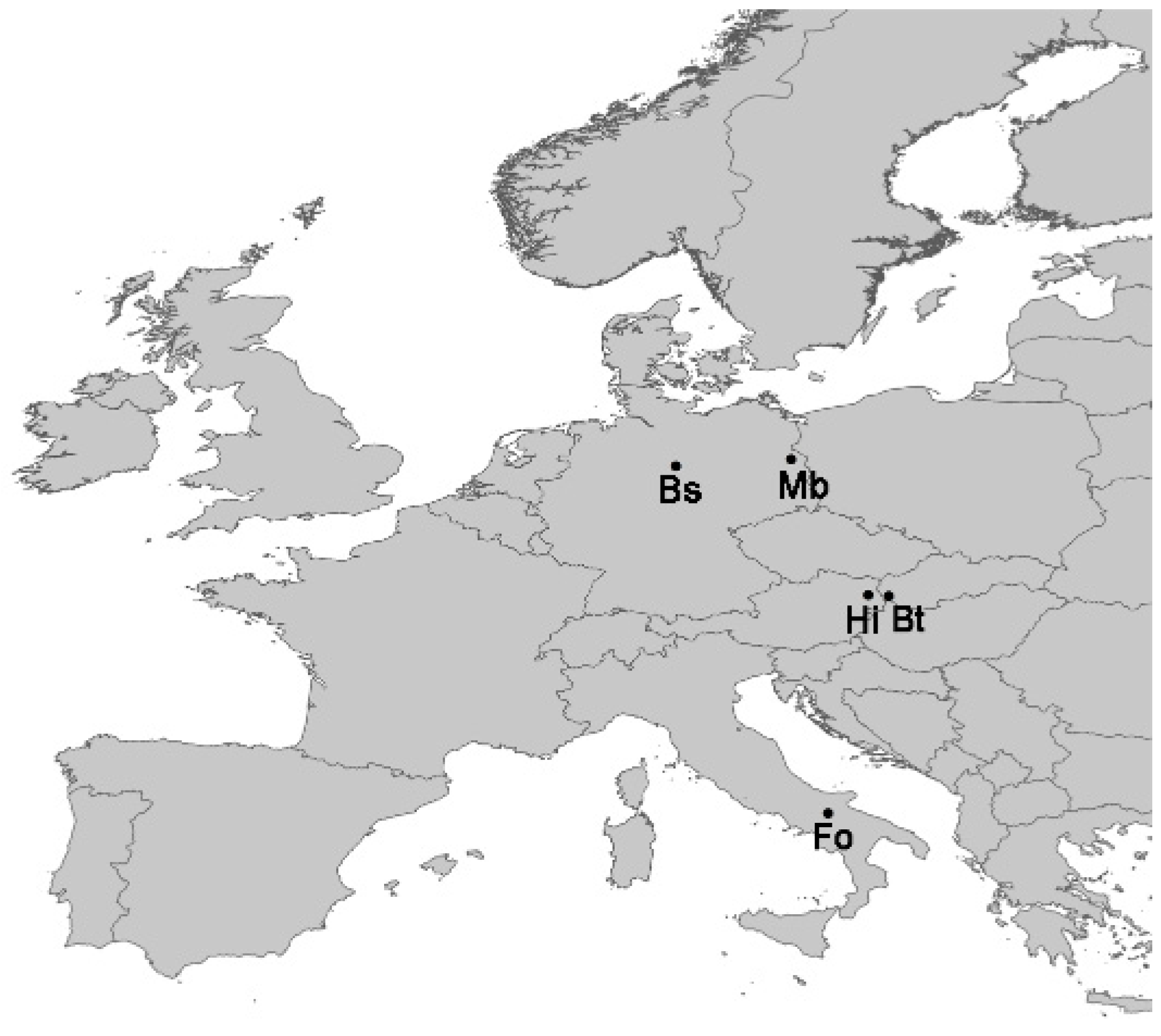

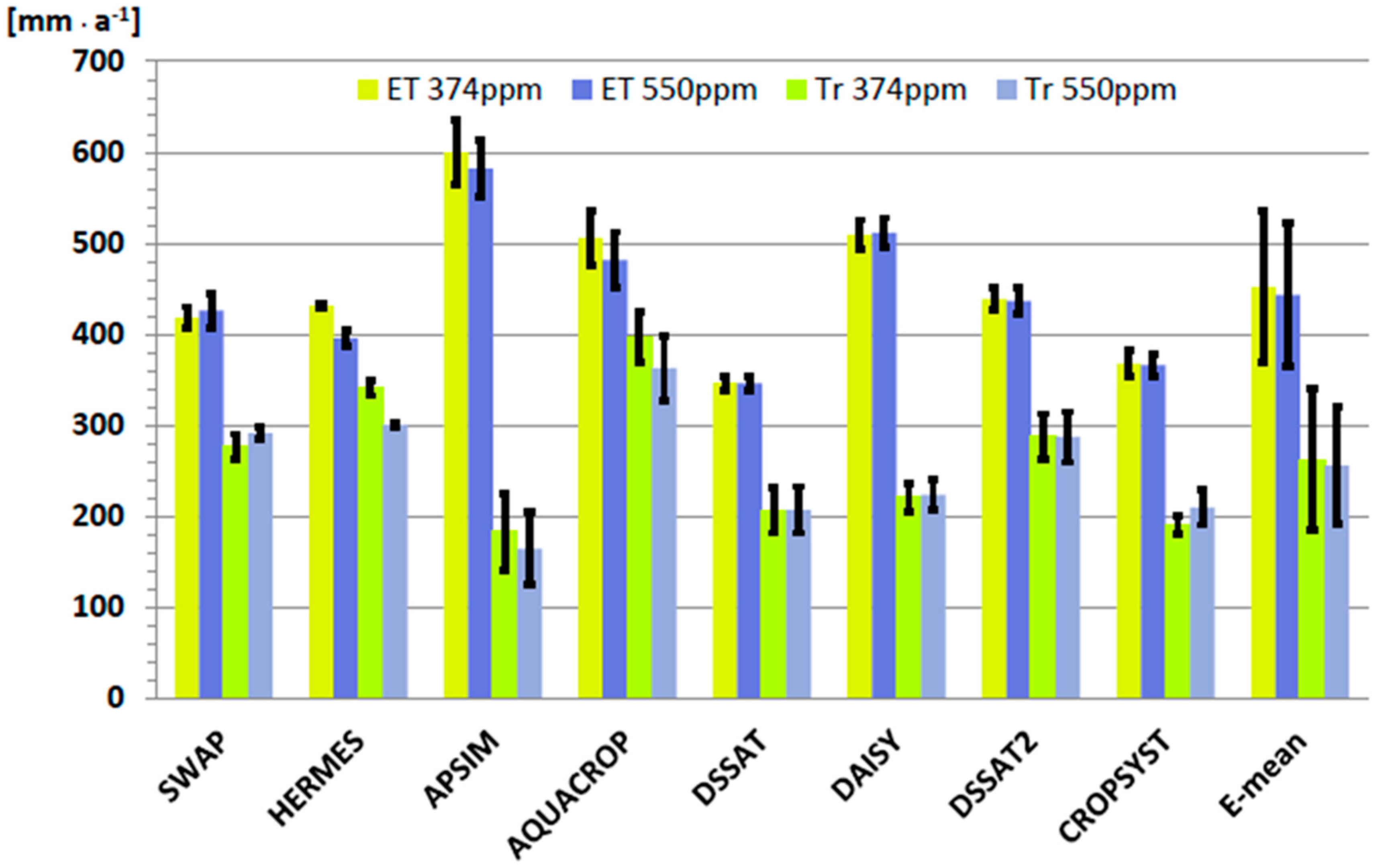
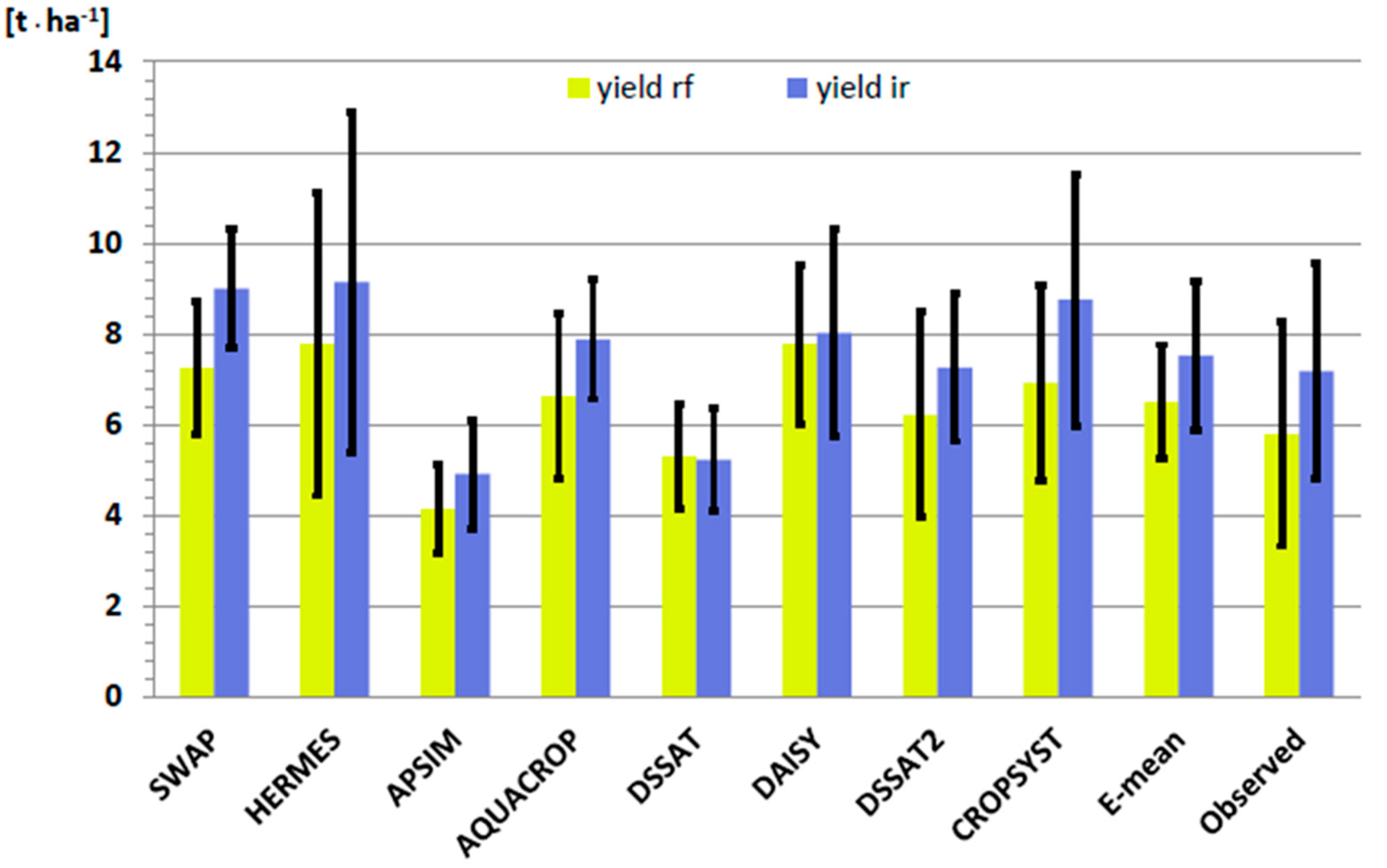
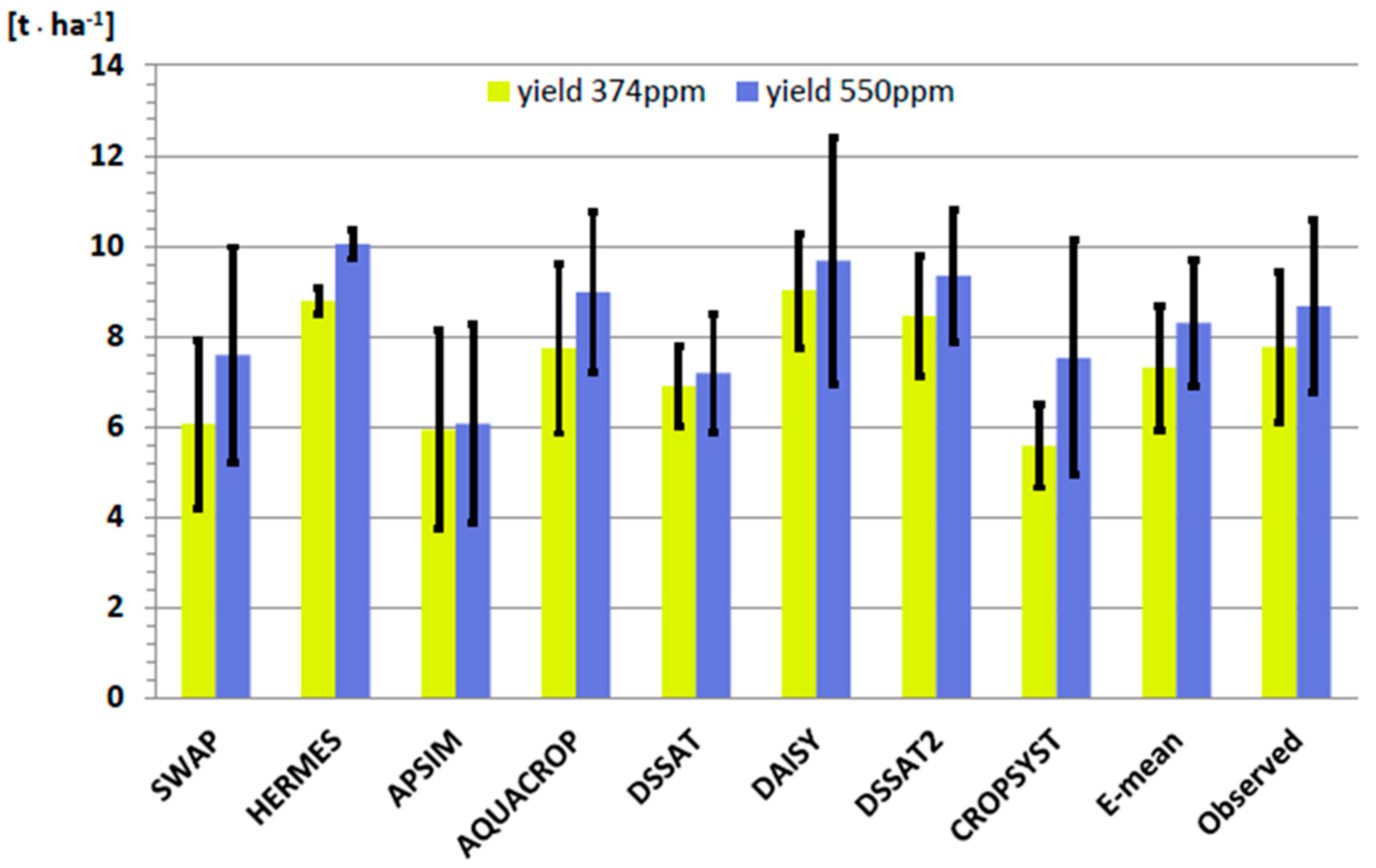
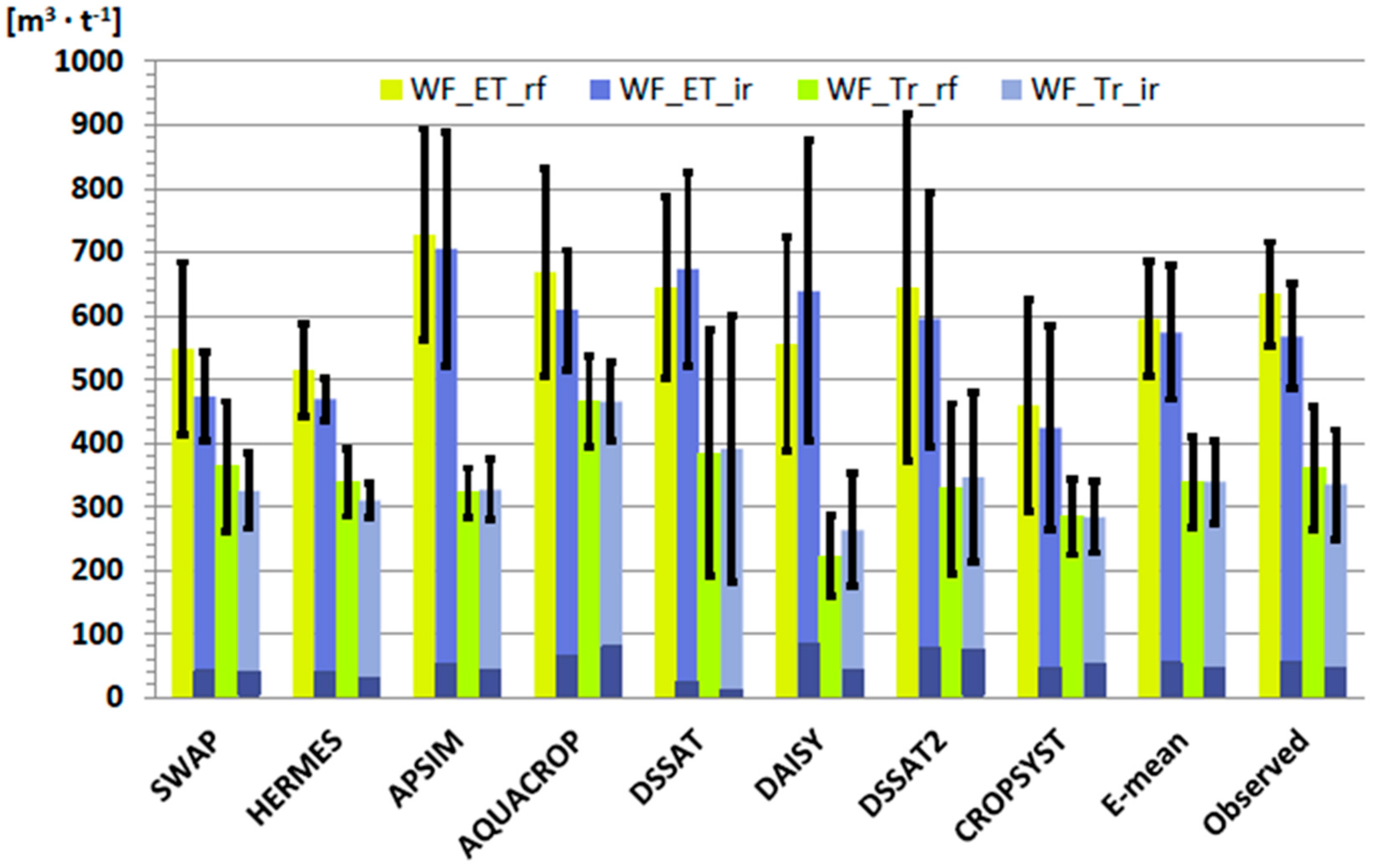
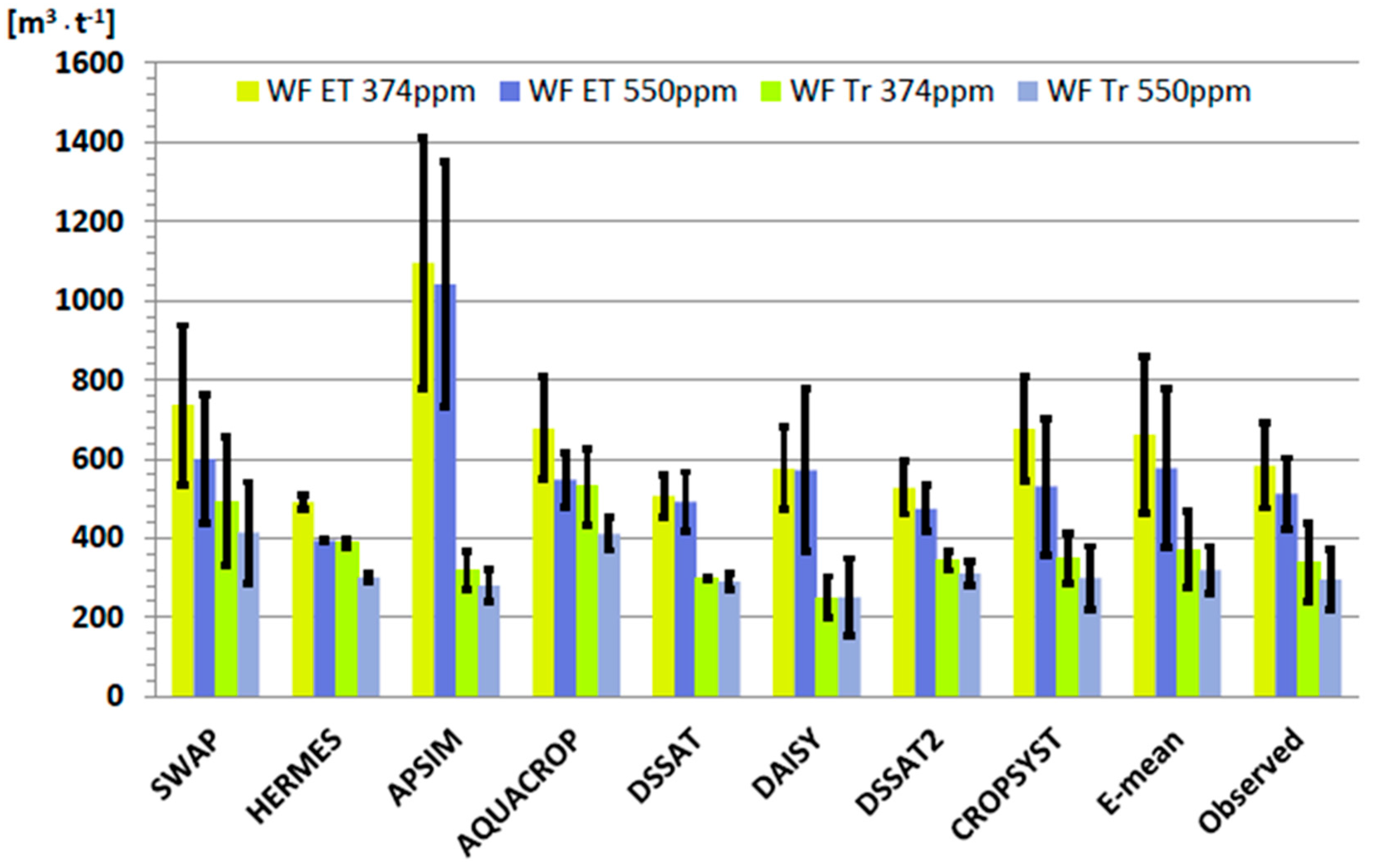
| Location/Country | Topography | Period | Climate * | Soil # S/Si/Cl/Corg | Treatment | Crops |
|---|---|---|---|---|---|---|
| Müncheberg/Germany | Lat: 52.52° Long: 14.12° Elev: 62 m a.s.l. | 1992–1998 | 8.4 °C 563 mm | 83/9/8/0.6 | shifted rotation, rainfed, irrigated | sugar beet, winter wheat, winter barley, winter rye (oil raddish) |
| Braunschweig/Germany | Lat: 52.3° Long: 10.45° Elev: 79 m a.s.l. | 1999–2005 | 10.0 °C 642 mm | 69/24/7/1.0 | 374/550 ppm CO2 2 nitrogen levels | winter barley, ryegrass (catchcrop), sugar beet, winter wheat |
| Hirschstetten/Austria | Lat: 48.2° Long: 16.57° Elev: 150 m a.s.l. | 1998–2003 | 10.9 °C 495 mm | 1: 22/50/28/2.9 2: 68/19/13/1.3 3: 22/54/24/1.3 | 3 soils | grain maize, winter wheat, spring barley, mustard , spring wheat, potatoes |
| Foggia/Italy | Lat: 41.26° Long: 15.30° Elev: 90 m a.s.l. | 1995–2005 | 15.9 °C 540 mm | 13/39/48/1.5 | Straw burned Straw remained with 0, 50, 100 and 150 kg N/ha | Durum wheat |
| Bratislava/Slovakia | Lat: 48.16° Long: 17.23° Elev: 130 m a.s.l. | 1998–2006 | 10.7 °C 575 mm | 19/59/22/1.7 | Rainfed, irrigated 2 nitrogen levels (0% and 100%) Residue management | w. wheat, maize, maize, maize, spr. barley, w. wheat, maize, spr. barley |
| Model | AQUA CROP | APSIM | DAISY | DSSAT | HERMES | SWAP/WOFOST | CROPSYST | |
|---|---|---|---|---|---|---|---|---|
| 4.5 | 4.6 | |||||||
| Abbreviation | AQ | AP | DA | DT | DS | HE | SW | CR |
| Light utilisation a | TE | RUE | P-R | RUE | P-R | P-R | TE/RUE | |
| Yield formation b | Y(HI,B) | Y(HI,B) | Y(Prt) | Y(HI(Gn),B) | Y(Prt) | Y(Prt,B) | Y(HI_mw/B) | |
| Crop phenology c | f(T, DL, V) | f(T, DL, V) | f(T, DL, V) | f(T, DL, V) | f(T, DL, V) | f(T, DL) | f(T, DL, V) | |
| Root distribution over depth d | EXP | LIN | EXP | EXP | EXP | LIN | EXP | |
| Stresses involved e | W, N k | W, N | W, N | W, N | W, N, A | W, N i | W, N | |
| Water dynamics f | C | C | R | C | C | R | C/R | |
| Evapotranspiration g | PM | PT | PM | PT | PM | PM | PT | |
| Soil CN-model h | - | CN, P(3), B | CN, P(6), B | CN, P(4), B | N, P(2) | - | N, P(4) | |
| Application at | Mb, Bs, Hi, Fo, Br | Mb, Bs, Hi, Fo | Mb, Bs, Hi, Fo, Br | Mb, Bs, Hi, Fo, Br | Mb, Bs, Hi, Fo, Br | Mb, Bs, Hi | Mb, Bs, Hi, Fo, Br | |
| Calibration * | T+R Ph | T+R Ph | T+R Ph | Aut 1 | Aut 2+ | T+R Ph | DF +Aut 3 Ph | T+R Ph |
| Ph | ||||||||
| Reference | [35] | [36] | [37] | [38] | [20] | [39] | [40] | |
| Model/Soil | ET (mm) | Tr (mm) | Yield (t·ha−1) | Yield obs. (t·ha−1) | WF (m3·t−1) | WF_Tr (m3·t−1) | WF_obs* (m3·t−1) | |||||||||||
|---|---|---|---|---|---|---|---|---|---|---|---|---|---|---|---|---|---|---|
| Ave | ± | CV% | Ave | ± | Ave | ± | CV% | Ave | ± | Ave | ± | CV% | Ave | ± | Ave | ± | CV% | |
| APSIM S1 | 469 | 11 | 316 | 5 | 8.37 | 0.35 | 5.19 | 0.67 | 560 | 11 | 378 | 22 | 903 | |||||
| S2 | 351 | 6 | 187 | 28 | 4.94 | 0.41 | 2.54 | 0.34 | 713 | 48 | 375 | 25 | 1383 | |||||
| S3 | 462 | 22 | 309 | 38 | 8.49 | 0.58 | 4.94 | 0.37 | 545 | 11 | 363 | 20 | 936 | |||||
| AQUACROP S1 | 452 | 62 | 394 | 57 | 5.15 | 0.85 | 5.19 | 0.67 | 881 | 27 | 768 | 17 | 871 | |||||
| S2 | 413 | 61 | 324 | 48 | 3.64 | 0.91 | 2.54 | 0.34 | 1164 | 123 | 913 | 96 | 1629 | |||||
| S3 | 487 | 46 | 421 | 38 | 5.20 | 0.89 | 4.94 | 0.37 | 949 | 75 | 821 | 69 | 986 | |||||
| CROPSYST S1 | 286 | 50 | 167 | 54 | 5.04 | 1.95 | 5.19 | 0.67 | 620 | 140 | 341 | 24 | 551 | |||||
| S2 | 321 | 52 | 186 | 43 | 5.48 | 1.70 | 2.54 | 0.34 | 614 | 95 | 348 | 30 | 1264 | |||||
| S3 | 304 | 56 | 172 | 46 | 5.15 | 1.72 | 4.94 | 0.37 | 624 | 100 | 342 | 25 | 617 | |||||
| DAISY S1 | 494 | 54 | 265 | 20 | 7.77 | 1.66 | 5.19 | 0.67 | 652 | 70 | 351 | 49 | 953 | |||||
| S2 | 460 | 61 | 240 | 26 | 5.79 | 0.75 | 2.54 | 0.34 | 821 | 211 | 428 | 100 | 1813 | |||||
| S3 | 478 | 60 | 252 | 26 | 7.97 | 1.77 | 4.94 | 0.37 | 614 | 61 | 325 | 40 | 969 | |||||
| DSSAT S1 | 346 | 39 | 227 | 1 | 8.28 | 0.48 | 5.19 | 0.67 | 422 | 72 | 275 | 17 | 668 | |||||
| S2 | 351 | 16 | 234 | 17 | 8.41 | 0.89 | 2.54 | 0.34 | 424 | 64 | 280 | 10 | 1384 | |||||
| S3 | 362 | 52 | 253 | 11 | 8.77 | 1.40 | 4.94 | 0.37 | 417 | 125 | 290 | 34 | 733 | |||||
| HERMES S1 | 403 | 56 | 341 | 31 | 4.52 | 2.31 | 5.19 | 0.67 | 1122 | 450 | 974 | 430 | 778 | |||||
| S2 | 362 | 60 | 279 | 36 | 3.70 | 1.35 | 2.54 | 0.34 | 1060 | 227 | 829 | 206 | 1428 | |||||
| S3 | 401 | 38 | 338 | 12 | 4.53 | 1.73 | 4.94 | 0.37 | 999 | 298 | 861 | 302 | 813 | |||||
| SWAP/WOFOST S1 | 350 | 37 | 227 | 7 | 5.14 | 0.72 | 5.19 | 0.67 | 683 | 27 | 445 | 50 | 674 | |||||
| S2 | 352 | 40 | 230 | 8 | 5.17 | 0.93 | 2.54 | 0.34 | 689 | 53 | 454 | 69 | 1389 | |||||
| S3 | 352 | 37 | 231 | 5 | 5.21 | 0.79 | 4.94 | 0.37 | 681 | 44 | 451 | 63 | 712 | |||||
| Ensemble S1 | 400 | 76 | 19 | 277 | 78 | 6.33 | 1.72 | 27 | 5.19 | 0.67 | 706 | 230 | 33 | 505 | 262 | 771 | 147 | 19 |
| S2 | 376 | 47 | 13 | 249 | 49 | 5.31 | 1.60 | 30 | 2.54 | 0.34 | 784 | 257 | 33 | 518 | 249 | 1470 | 187 | 13 |
| S3 | 397 | 71 | 18 | 278 | 81 | 6.48 | 1.84 | 28 | 4.94 | 0.37 | 690 | 211 | 31 | 493 | 243 | 824 | 144 | 17 |
| Model/Treatment | ET (mm) | Tr (mm) | Yield (t·ha−1) | Yield obs. (t·ha−1) | WF (m3·t−1) | WF_Tr (m3·t−1) | WF_obs* (m3·t−1) | |||||||||||
|---|---|---|---|---|---|---|---|---|---|---|---|---|---|---|---|---|---|---|
| Ave | std | CV% | Ave | std | Ave | std | CV% | Ave | std | Ave | std | CV% | Ave | std | Ave | std | CV% | |
| APSIM T2 | 310 | 28 | 178 | 26 | 4.45 | 1.03 | 3.23 | 1.30 | 718 | 109 | 408 | 55 | 1206 | 824 | ||||
| T3 | 323 | 31 | 196 | 28 | 5.09 | 1.37 | 3.08 | 1.29 | 664 | 135 | 399 | 71 | 1418 | 1196 | ||||
| T4 | 334 | 35 | 209 | 31 | 5.65 | 1.81 | 3.04 | 1.24 | 637 | 165 | 393 | 85 | 1466 | 1210 | ||||
| T5 | 338 | 34 | 214 | 30 | 5.78 | 1.85 | 2.96 | 1.26 | 632 | 167 | 395 | 86 | 1615 | 1525 | ||||
| AQUACROP T2 | 340 | 14 | 222 | 17 | 3.32 | 0.18 | 3.23 | 1.30 | 1025 | 62 | 667 | 37 | 1324 | 234 | ||||
| T3 | 343 | 13 | 233 | 18 | 3.42 | 0.18 | 3.08 | 1.29 | 1005 | 80 | 682 | 54 | 1527 | 243 | ||||
| T4 | 366 | 25 | 247 | 25 | 3.57 | 0.29 | 3.04 | 1.24 | 1029 | 78 | 696 | 87 | 1532 | 231 | ||||
| T5 | 384 | 33 | 261 | 35 | 3.78 | 0.42 | 2.96 | 1.26 | 1022 | 100 | 696 | 106 | 1673 | 247 | ||||
| CROPSYST T2 | 346 | 25 | 96 | 33 | 2.31 | 0.73 | 3.23 | 1.30 | 1799 | 1180 | 413 | 37 | 1335 | 901 | ||||
| T3 | 345 | 23 | 98 | 33 | 2.35 | 0.74 | 3.08 | 1.29 | 1766 | 1186 | 412 | 38 | 1507 | 1295 | ||||
| T4 | 345 | 23 | 98 | 33 | 2.35 | 0.74 | 3.04 | 1.24 | 1766 | 1186 | 412 | 38 | 1497 | 1212 | ||||
| T5 | 345 | 23 | 98 | 33 | 2.35 | 0.74 | 2.96 | 1.26 | 1766 | 1186 | 412 | 38 | 1626 | 1507 | ||||
| DAISY T2 | 440 | 50 | 235 | 35 | 3.06 | 1.03 | 3.23 | 1.30 | 1546 | 410 | 827 | 239 | 1704 | 1223 | ||||
| T3 | 440 | 50 | 236 | 36 | 4.32 | 1.90 | 3.08 | 1.29 | 1201 | 513 | 647 | 293 | 1939 | 1750 | ||||
| T4 | 440 | 50 | 236 | 37 | 5.17 | 2.03 | 3.04 | 1.24 | 973 | 377 | 526 | 220 | 1926 | 1640 | ||||
| T5 | 440 | 50 | 236 | 37 | 6.07 | 2.24 | 2.96 | 1.26 | 824 | 328 | 444 | 183 | 2095 | 2033 | ||||
| DSSAT T2 | 283 | 30 | 146 | 61 | 4.10 | 2.20 | 3.23 | 1.30 | 926 | 554 | 383 | 67 | 1082 | 698 | ||||
| T3 | 298 | 28 | 179 | 43 | 5.44 | 1.66 | 3.08 | 1.29 | 591 | 175 | 336 | 48 | 1301 | 1114 | ||||
| T4 | 302 | 30 | 198 | 43 | 6.54 | 1.61 | 3.04 | 1.24 | 494 | 153 | 309 | 46 | 1313 | 1066 | ||||
| T5 | 306 | 31 | 211 | 42 | 7.37 | 1.53 | 2.96 | 1.26 | 442 | 148 | 292 | 48 | 1441 | 1337 | ||||
| HERMES T2 | 337 | 54 | 160 | 48 | 3.11 | 2.01 | 3.23 | 1.30 | 1709 | 1278 | 731 | 438 | 1293 | 932 | ||||
| T3 | 335 | 54 | 167 | 48 | 3.72 | 2.34 | 3.08 | 1.29 | 1391 | 975 | 649 | 411 | 1468 | 1340 | ||||
| T4 | 335 | 52 | 170 | 54 | 3.75 | 2.38 | 3.04 | 1.24 | 1386 | 973 | 651 | 406 | 1460 | 1258 | ||||
| T5 | 335 | 52 | 171 | 57 | 3.76 | 2.41 | 2.96 | 1.26 | 1384 | 974 | 651 | 406 | 1589 | 1561 | ||||
| Ensemble T2 | 343 | 53 | 15 | 173 | 51 | 3.39 | 0.77 | 23 | 3.23 | 1.30 | 1287 | 454 | 35 | 571 | 194 | 1327 | 209 | 16 |
| T3 | 347 | 49 | 14 | 185 | 51 | 4.06 | 1.14 | 28 | 3.08 | 1.29 | 1103 | 447 | 40 | 521 | 154 | 1527 | 217 | 14 |
| T4 | 354 | 47 | 13 | 193 | 54 | 4.50 | 1.55 | 34 | 3.04 | 1.24 | 1047 | 472 | 45 | 498 | 153 | 1543 | 209 | 14 |
| T5 | 358 | 47 | 13 | 199 | 58 | 4.85 | 1.86 | 38 | 2.96 | 1.26 | 1012 | 492 | 49 | 482 | 158 | 1694 | 227 | 13 |
| Model/Treatment | ET (mm) | Tr (mm) | Yield (t·ha−1) | Yield obs. (t·ha−1) | WF (m3·t−1) | WF_Tr (m3·t−1) | WF_obs* (m3·t−1) | |||||||||||
|---|---|---|---|---|---|---|---|---|---|---|---|---|---|---|---|---|---|---|
| Ave | std | CV% | Ave | std | Ave | std | CV% | Ave | std | Ave | std | CV% | Ave | std | Ave | std | CV% | |
| AQUACROP RF0 | 488 | 26 | 353 | 53 | 6.35 | 1.02 | 5.74 | 0.10 | 780 | 102 | 557 | 11 | 745 | 137 | ||||
| RFF | 506 | 28 | 455 | 47 | 7.86 | 0.76 | 7.50 | 1.89 | 646 | 28 | 578 | 13 | 751 | 111 | ||||
| IR0 | 525 | 4 | 403 | 26 | 7.23 | 0.48 | 6.04 | 0.44 | 729 | 46 | 558 | 12 | 847 | 185 | ||||
| IRF | 536 | 15 | 486 | 35 | 8.33 | 0.62 | 7.69 | 1.98 | 645 | 30 | 584 | 14 | 824 | 192 | ||||
| CROPSYST RF0 | 398 | 17 | 189 | 9 | 5.33 | 0.30 | 5.74 | 0.10 | 747 | 18 | 355 | 4 | 693 | 24 | ||||
| RFF | 395 | 14 | 190 | 10 | 5.36 | 0.34 | 7.50 | 1.89 | 738 | 21 | 355 | 4 | 550 | 126 | ||||
| IR0 | 420 | 25 | 211 | 20 | 5.90 | 0.56 | 6.04 | 0.44 | 714 | 33 | 358 | 5 | 695 | 20 | ||||
| IRF | 429 | 3 | 224 | 5 | 6.23 | 0.05 | 7.69 | 1.98 | 688 | 1 | 359 | 6 | 589 | 163 | ||||
| DAISY RF0 | 596 | 7 | 276 | 2 | 4.66 | 0.64 | 5.74 | 0.10 | 1299 | 208 | 601 | 90 | 1039 | 14 | ||||
| RFF | 597 | 7 | 278 | 1 | 8.95 | 2.28 | 7.50 | 1.89 | 699 | 171 | 327 | 85 | 834 | 209 | ||||
| IR0 | 596 | 8 | 269 | 1 | 5.10 | 0.49 | 6.04 | 0.44 | 1179 | 135 | 532 | 57 | 991 | 65 | ||||
| IRF | 597 | 8 | 271 | 1 | 9.67 | 1.47 | 7.69 | 1.98 | 627 | 90 | 285 | 43 | 817 | 212 | ||||
| DSSAT RF0 | 435 | 42 | 162 | 11 | 5.35 | 1.30 | 5.74 | 0.10 | 870 | 167 | 326 | 71 | 757 | 66 | ||||
| RFF | 437 | 35 | 173 | 1 | 5.53 | 1.01 | 7.50 | 1.89 | 688 | 52 | 272 | 1 | 603 | 112 | ||||
| IR0 | 437 | 44 | 162 | 12 | 6.35 | 0.02 | 6.04 | 0.44 | 771 | 30 | 288 | 19 | 723 | 41 | ||||
| IRF | 438 | 35 | 173 | 0 | 6.35 | 0.02 | 7.69 | 1.98 | 689 | 53 | 273 | 1 | 592 | 116 | ||||
| HERMES RF0 | 460 | 37 | 340 | 25 | 8.28 | 1.96 | 5.74 | 0.10 | 572 | 94 | 423 | 71 | 802 | 73 | ||||
| RFF | 458 | 37 | 350 | 26 | 9.91 | 2.18 | 7.50 | 1.89 | 473 | 66 | 362 | 53 | 651 | 219 | ||||
| IR0 | 476 | 33 | 357 | 20 | 8.89 | 1.27 | 6.04 | 0.44 | 540 | 48 | 405 | 39 | 793 | 109 | ||||
| IRF | 478 | 30 | 371 | 18 | 11.22 | 0.76 | 7.69 | 1.98 | 426 | 17 | 331 | 12 | 663 | 218 | ||||
| Ensemble RF0 | 475 | 75 | 16 | 264 | 86 | 5.96 | 1.43 | 24 | 5.74 | 0.10 | 854 | 272 | 32 | 452 | 122 | 807 | 135 | 17 |
| RFF | 479 | 77 | 16 | 289 | 117 | 7.69 | 1.85 | 24 | 7.50 | 1.89 | 649 | 104 | 16 | 379 | 117 | 678 | 114 | 17 |
| IR0 | 491 | 72 | 15 | 281 | 100 | 6.56 | 1.52 | 23 | 6.04 | 0.44 | 786 | 236 | 30 | 428 | 115 | 810 | 117 | 14 |
| IRF | 495 | 71 | 14 | 305 | 125 | 8.36 | 2.15 | 26 | 7.69 | 1.98 | 615 | 109 | 18 | 366 | 127 | 697 | 117 | 17 |
© 2016 by the authors; licensee MDPI, Basel, Switzerland. This article is an open access article distributed under the terms and conditions of the Creative Commons Attribution (CC-BY) license (http://creativecommons.org/licenses/by/4.0/).
Share and Cite
Kersebaum, K.C.; Kroes, J.; Gobin, A.; Takáč, J.; Hlavinka, P.; Trnka, M.; Ventrella, D.; Giglio, L.; Ferrise, R.; Moriondo, M.; et al. Assessing Uncertainties of Water Footprints Using an Ensemble of Crop Growth Models on Winter Wheat. Water 2016, 8, 571. https://doi.org/10.3390/w8120571
Kersebaum KC, Kroes J, Gobin A, Takáč J, Hlavinka P, Trnka M, Ventrella D, Giglio L, Ferrise R, Moriondo M, et al. Assessing Uncertainties of Water Footprints Using an Ensemble of Crop Growth Models on Winter Wheat. Water. 2016; 8(12):571. https://doi.org/10.3390/w8120571
Chicago/Turabian StyleKersebaum, Kurt Christian, Joop Kroes, Anne Gobin, Jozef Takáč, Petr Hlavinka, Miroslav Trnka, Domenico Ventrella, Luisa Giglio, Roberto Ferrise, Marco Moriondo, and et al. 2016. "Assessing Uncertainties of Water Footprints Using an Ensemble of Crop Growth Models on Winter Wheat" Water 8, no. 12: 571. https://doi.org/10.3390/w8120571







